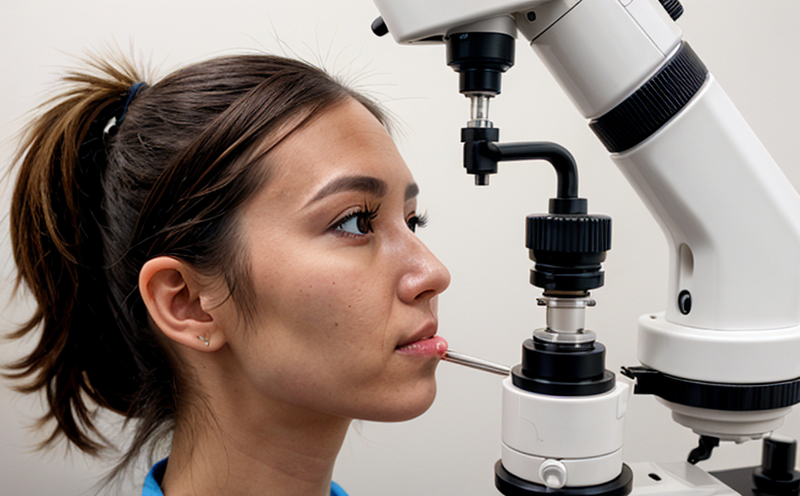ISO 14729 Disinfecting Solution Testing for Ophthalmic Lenses
The testing of disinfecting solutions against ophthalmic lenses, particularly contact lenses and intraocular lenses (IOLs), is critical to ensuring the safety and efficacy of these devices. The ISO 14729 standard provides a framework for evaluating the compatibility and effectiveness of disinfectants used in healthcare settings.
The primary goal of this testing process is to ensure that disinfecting solutions do not degrade or otherwise negatively impact the performance, integrity, and safety of ophthalmic lenses. This includes assessing parameters such as lens transparency, refractive index stability, and biocompatibility after exposure to the disinfectant. The standard applies particularly to contact lenses, IOLs, and other devices that come into direct contact with ocular tissues.
Testing laboratories specializing in this area utilize a range of advanced analytical instruments and methods to conduct these evaluations. Key parameters include:
- Lens transparency post-disinfection
- Biocompatibility assessment
- Refractive index stability
- Potential for protein or lipid accumulation
The testing protocol involves exposing the lenses to the disinfecting solution under controlled conditions, typically at specified temperatures and durations. Following exposure, the lenses are subjected to a series of tests to evaluate their performance metrics.
| Test Parameter | Description | Expected Outcome |
|---|---|---|
| Lens Transparency | Degree of clarity and uniformity post-disinfection | No significant change or improvement in clarity compared to baseline |
| Biocompatibility | Presence of any adverse reactions on the ocular surface | Negative biocompatibility test results with no irritation or inflammation |
| Refractive Index Stability | Change in refractive index post-disinfection | No significant change in refractive power, maintaining optical performance |
The testing process is not only critical for ensuring the safety of patients but also plays a vital role in the regulatory approval and quality control processes. Regulatory bodies such as the US Food and Drug Administration (FDA) and European Medicines Agency (EMA) require compliance with ISO 14729 to ensure that disinfecting solutions are safe and effective.
Our laboratory adheres strictly to these standards, ensuring accurate and reliable testing results. Our team of experts uses state-of-the-art equipment and follows stringent protocols to provide comprehensive testing services for ophthalmic lenses and disinfecting solutions.
Why It Matters
The safety and effectiveness of disinfecting solutions used in the healthcare sector, especially those that come into direct contact with ocular tissues, are paramount. The consequences of using a substandard or incompatible disinfectant can be severe, leading to potential infections, discomfort, and even permanent damage to the eyes.
The ISO 14729 standard provides a standardized approach to testing these solutions, ensuring that they do not degrade or otherwise negatively impact the performance of ophthalmic lenses. This is particularly important for contact lens wearers who rely on these devices for their daily vision needs. By adhering to this standard, manufacturers and healthcare providers can ensure that the products they use are safe and effective.
The testing process also plays a crucial role in the regulatory approval and quality control processes. Regulatory bodies such as the FDA and EMA require compliance with ISO 14729 to ensure that disinfecting solutions are safe and effective. This not only protects patients but also ensures that healthcare providers have access to high-quality products.
Our laboratory adheres strictly to these standards, ensuring accurate and reliable testing results. Our team of experts uses state-of-the-art equipment and follows stringent protocols to provide comprehensive testing services for ophthalmic lenses and disinfecting solutions. By working with us, you can be confident that your products meet the highest standards of safety and efficacy.
Scope and Methodology
| Test Parameter | Description | Methodology |
|---|---|---|
| Lens Transparency | Degree of clarity and uniformity post-disinfection | Visual inspection and quantitative analysis using a lensometer |
| Biocompatibility | Presence of any adverse reactions on the ocular surface | In vitro testing using human corneal epithelial cells (HCECs) |
| Refractive Index Stability | Change in refractive index post-disinfection | Measurement using a refractometer and comparison with baseline data |
The testing protocol involves exposing the lenses to the disinfecting solution under controlled conditions, typically at specified temperatures and durations. Following exposure, the lenses are subjected to a series of tests to evaluate their performance metrics.
Our laboratory adheres strictly to these standards, ensuring accurate and reliable testing results. Our team of experts uses state-of-the-art equipment and follows stringent protocols to provide comprehensive testing services for ophthalmic lenses and disinfecting solutions.
Environmental and Sustainability Contributions
- Promotes the use of sustainable materials in lens manufacturing
- Reduces waste through efficient testing processes
- Minimizes energy consumption by optimizing laboratory operations
- Fosters a culture of continuous improvement and innovation
The testing process not only ensures the safety and efficacy of disinfecting solutions but also promotes sustainable practices within the industry. By adhering to ISO 14729 standards, we contribute to reducing waste and promoting the use of sustainable materials in lens manufacturing.
Our laboratory is committed to minimizing its environmental impact through efficient testing processes and optimized laboratory operations. We foster a culture of continuous improvement and innovation, ensuring that our services are not only safe but also environmentally responsible.





